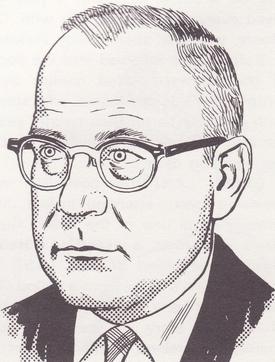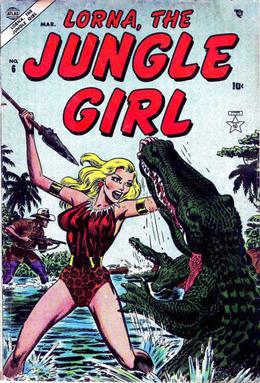
Gardner Francis Cooper Fox was an American writer known best for creating numerous comic book characters for DC Comics. He is estimated to have written more than 4,000 comics stories, including 1,500 for DC Comics. Fox was also a science fiction author and wrote many novels and short stories.

Sheena, Queen of the Jungle, is a fictional American comic book jungle girl heroine, originally published primarily by Fiction House during the Golden Age of Comic Books. She was the first female comic book character with her own title, with her 1941 premiere issue preceding Wonder Woman #1. Sheena inspired a wealth of similar comic book jungle queens. She was predated in literature by Rima, the Jungle Girl, introduced in the 1904 William Henry Hudson novel Green Mansions.

Showcase is a comic anthology series published by DC Comics. The general theme of the series was to feature new and minor characters as a way to gauge reader interest in them, without the difficulty and risk of featuring untested characters in their own ongoing titles. Showcase is regarded as the most successful of such tryout series, having been published continuously for more than 14 years, launching numerous popular titles, and maintaining a considerable readership of its own. The series ran from March–April 1956 to September 1970, suspending publication with issue #93, and then was revived for eleven issues from August 1977 to September 1978.
"Charles Nicholas" is the pseudonymous house name of three early creators of American comic books for the Fox Feature Syndicate and Fox Comics: Chuck Cuidera (1915–2001), Jack Kirby (1917–1994), and Charles Wojtkoski (1921–1985). The name originated at Eisner & Iger, one of the first comic book packagers that created comics on demand for publishers entering the new medium during the 1930s–1940s Golden Age of comic books. The three creators are listed in order of birth year, below.

Fiction House was an American publisher of pulp magazines and comic books that existed from the 1920s to the 1950s. It was founded by John B. "Jack" Kelly and John W. Glenister. By the late 1930s, the publisher was Thurman T. Scott. Its comics division was best known for its pinup-style good girl art, as epitomized by the company's most popular character, Sheena, Queen of the Jungle.
Bob Powell was an American comic book artist known for his work during the 1930–1940s Golden Age of comic books, including on the features "Sheena, Queen of the Jungle" and "Mr. Mystic". He received a belated credit in 1999 for co-writing the debut of the popular feature "Blackhawk". Powell also did the pencil art for the bubble gum trading card series Mars Attacks. He officially changed his name to S. Robert Powell in 1943.
A-1 Comics is a Golden Age comics publication that began in 1944 and ended in 1955, lasting 139 issues. Only the first 17 issues carried the title "A-1" on the cover. Issues #18 and up used the feature as the book title with different numbering. A-1 and its numbering continued to be used in the indicia. The series was used by owner Vincent Sullivan's Magazine Enterprises to try out a number of potential characters and titles, as well as reprinting newspaper strips such as Texas Slim, Kerry Drake and Teena. Several original A-1 titles succeeded and were given their own titles, including Tim Holt and The Ghost Rider. Issues were devoted to Thun'da, Cave Girl, and Strongman. Title that didn't do well included Dick Powell Adventurer, Fibber McGee and Molly, and Jimmy Durante Comics. The final issue was devoted to Bob Powell's Strongman.

Tarzanesque is a term created by Frenchman Francis Lacassin used to describe characters in comic books inspired by Tarzan. A tarzanesque character resembles Tarzan in his physical resourcefulness, within a line of action that includes an adventurous life in the jungle, the gift of understanding and being understood by animals, contact with lost civilizations and courage combined with the ability to deal with nature. The creation of such characters may have been propitiated by the success that Tarzan had achieved since his appearance in literature in 1912, culminating with the release of daily comic strips in 1929, which paved the way for a genre that combined the allure of the unknown environment, the need for the archetypal characteristics of the hero and the popularity of access.

Blue Ribbon Comics is the name of two American comic book anthology series, the first published by the Archie Comics predecessor MLJ Magazines Inc., commonly known as MLJ Comics, from 1939 to 1942, during the Golden Age of Comic Books. The revival was the second comic published in the 1980s by Archie Comics under the Red Circle and Archie Adventure Series banners.

A jungle girl is an archetype or stock character, often used in popular fiction, of a female adventurer, superhero or even a damsel in distress living in a jungle or rainforest setting. An alternate depiction is a cave girl.

Magazine Enterprises was an American comic book company lasting from 1943 to 1958, which published primarily Western, humor, crime, adventure, and children's comics, with virtually no superheroes. It was founded by Vin Sullivan, an editor at Columbia Comics and before that the editor at National Allied Publications, the future DC Comics.

Rulah, Jungle Goddess is a fictional character, a jungle girl, in comic books published by Fox Feature Syndicate. She first appeared in Zoot Comics #7. Matt Baker designed her, before Jack Kamen and Graham Ingels helped develop her image.

Fantomah is an American comics character, best known as one of the earliest comic-book superheroines. Created by Fletcher Hanks, the character first appeared in Jungle Comics #2, published by Fiction House. Hanks is also known for creating the equally strange Stardust the Super Wizard.

John Ogden Whitney was an American comic-book artist and sometime writer active from the 1930s–1940s Golden Age of comics through the 1960s Silver Age. He is best known as co-creator of the aviator hero Skyman and of the superpowered novelty character Herbie Popnecker and his alter ego, the satiric superhero the Fat Fury. Whitney as well had long runs on characters as diverse as the Western masked crime-fighter the Two-Gun Kid, and the career-girl character Millie the Model.

Thun'da is a fictional character created by artist and conceptualist Frank Frazetta for comic-book publisher Magazine Enterprises. The character debuted in Thun'da #1 (1952), with writer Gardner Fox scripting. After only a few issues the title was discontinued in 1953.

Lorna the Jungle Girl, initially called Lorna the Jungle Queen, is a comic book jungle girl protagonist created by writer Don Rico and artist Werner Roth. She debuted in Lorna the Jungle Queen #1, published by Marvel Comics' 1950s predecessor, Atlas Comics.

Space Adventures was an American science-fiction anthology comic book series published sporadically by Charlton Comics from 1952 to 1979. Its initial iteration included some of the earliest work of industry notables Steve Ditko, Dick Giordano, and Tony Tallarico, and at least one story by EC Comics mainstay Bernard Krigstein.

Good Girl Art (GGA) is a style of artwork depicting women primarily featured in comic books, comic strips, and pulp magazines. The term was coined by the American Comic Book Company, appearing in its mail order catalogs from the 1930s to the 1970s, and is used by modern comic experts to describe the hyper-sexualized version of femininity depicted in comics of the era.

All-Flash, originally published as All-Flash Quarterly, was a comic book magazine series published by All-American Publications and later National Periodicals featuring superhero Jay Garrick, the original Flash. The series was the first solo feature given to the Flash, who also appeared in the anthologies Flash Comics, All-Star Comics, and Comic Cavalcade. It ran for 32 issues from 1941 to 1947 and was originally published on a quarterly basis before changing over to a bi-monthly schedule with issue #6. Each issue regularly contained several stories featuring the Flash, as well as minor back-up features like Hop Harrigan, Butch McLobster, The Super Mobster, and Fat and Slat by cartoonist Ed Wheelan and, in later issues, Ton-O-Fun by Flash co-creator Harry Lampert.

Jumbo Comics was an adventure anthology comic book published by Fiction House from 1938–1953. Jumbo Comics was Fiction House's first comics title; the publisher had previously specialized in pulp magazines. The lead feature for Jumbo Comics' entire run was Sheena, Queen of the Jungle.
















